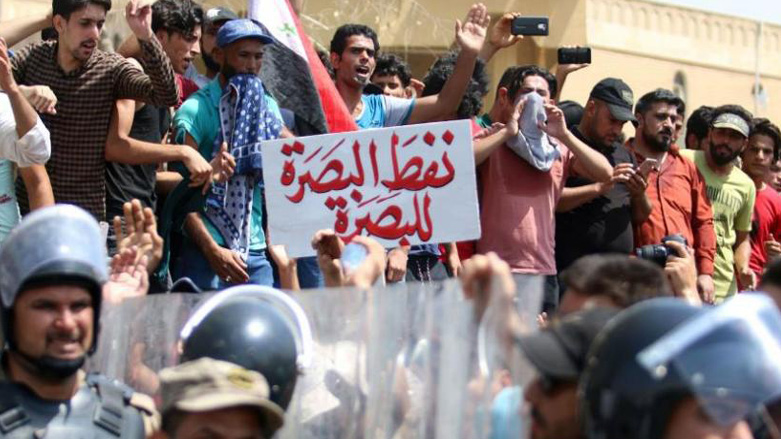Are Iraqi protests making Tehran nervous?

WASHINGTON DC (Kurdistan24) – As the US moves to implement tough new sanctions against Tehran, Iranian Defense Minister, Brig. Gen. Amir Hatami, affirmed on Monday that “Iran is enjoying a high level of security.”
Hatami claimed “the enemies” of Iran had sought to divide the country by supporting “terrorist groups” and separating the people from the government through sanctions.
Hatami’s statement came as protests continued to rock Shia areas of neighboring Iraq, with many demonstrations carrying an anti-Iranian message. Iraqis see their ruling class as associated with Iran, rather than the US, testimony, perhaps, to the waning US influence there in the 15 years since US forces overthrew Saddam Hussein.
Iraq has shut down the internet in an effort to quell the anti-government demonstrations, but scenes of the protests continue to emerge.
One such video came from Muthanna on Monday, where young protestors ripped up pictures of Iran’s Supreme Leader, Ali Khamenei, as they shouted, “No, No to Iran.”
Entifadh Qanbar, an Iraqi-American and President of the Future Foundation in Washington DC, suggested to Kurdistan 24 that the unrest in Iraq, particularly given its pronounced anti-Iranian aspects, was making authorities in Tehran “nervous” about their own internal situation.
Starting late last year, Iran has witnessed a series of protests. They began in the eastern shrine city of Mashhad, followed by anti-government demonstrations in Iranian Kurdistan and Tehran, and eventually spreading to over 100 cities.
Two weeks ago, the southwestern city of Khorramshahr saw protests, precipitated by dirty drinking water. They quickly took on a political dimension as videos circulating on social media showed large crowds, shouting “Death to [Iranian President Hassan] Rouhani,” The Wall Street Journal reported.
Khorramshahr lies 50 kilometers southeast of Basra, just across the Shatt al-Arab, the riverine border separating Iran and Iraq.
Khorramshahr is Arabic-speaking and was once known as Muhamarrah. The province in which it is located—Khuzestan—was once known as Arabistan.
Indeed, it almost appears as if the unrest now shaking Iraq’s Shia regions, which started within Iraq in the port city of Basra, really began in Iran—a point that would not have escaped the notice of Iranian authorities, as well as its corollary: the demonstrations in Iraq can spill back into Iran.
The unrest in Khorramshahr actually began after protests in Tehran’s bazaar, a regime stronghold. A dramatic fall in the value of the Iranian rial precipitated those demonstrations.
The depreciation of the Iranian currency was, in turn, brought about by the US withdrawal from the Iranian nuclear deal, followed by repeated affirmations that Washington intended to cut Iranian oil exports to zero by November 4.
“Iran’s corrupt regime is wasting the country’s resources on Assad, Hezbollah, Hamas, and Houthis, while Iranians struggle,” US Secretary of State Mike Pompeo tweeted, as the bazaaris protested.
“People are tired of the corruption, injustice & incompetence of their leaders. The world hears their voice,” he continued.
Iran’s Defense Minister claimed that the “enemies” had concocted a variety of plots against the country and that last September’s independence referendum in Iraqi Kurdistan was among them.
“The people and authorities of Kurdistan were keen to live within the framework of the official borders of Iraq,” Hatami said—although 93 percent of the people of the Kurdistan Region voted for independence.
He then incongruously asserted that the “plot” was thwarted “through the vigilance of the people of the Kurdistan Region of Iraq, and in particular, the officials of Turkey, Iraq, and Iran.”
Ironically, the US played a key role in thwarting that “plot.” Its strong opposition to the referendum encouraged the opposition of Iraqi Prime Minister Haider al-Abadi, Ryan Crocker, former US ambassador to Iraq, said shortly after the vote, as he criticized the US position.
The Iraqi assault on Kirkuk, in a military operation engineered by Iran, followed three weeks later.
The US was then—and apparently still remains—strongly committed to a “one-Iraq” policy, and, along with it, the government in Baghdad.
So it is a second irony that US efforts to isolate and contain Iran look as if they have contributed to shaking Iraq, raising the question: just whom does the government represent?
Certainly, not the Sunni Arabs of Iraq, who are scarcely represented, and not the Kurds, who overwhelmingly expressed their desire for independence. And now, it seems, many of Iraq’s Shias reject their rulers, as well.
Editing by Nadia Riva
